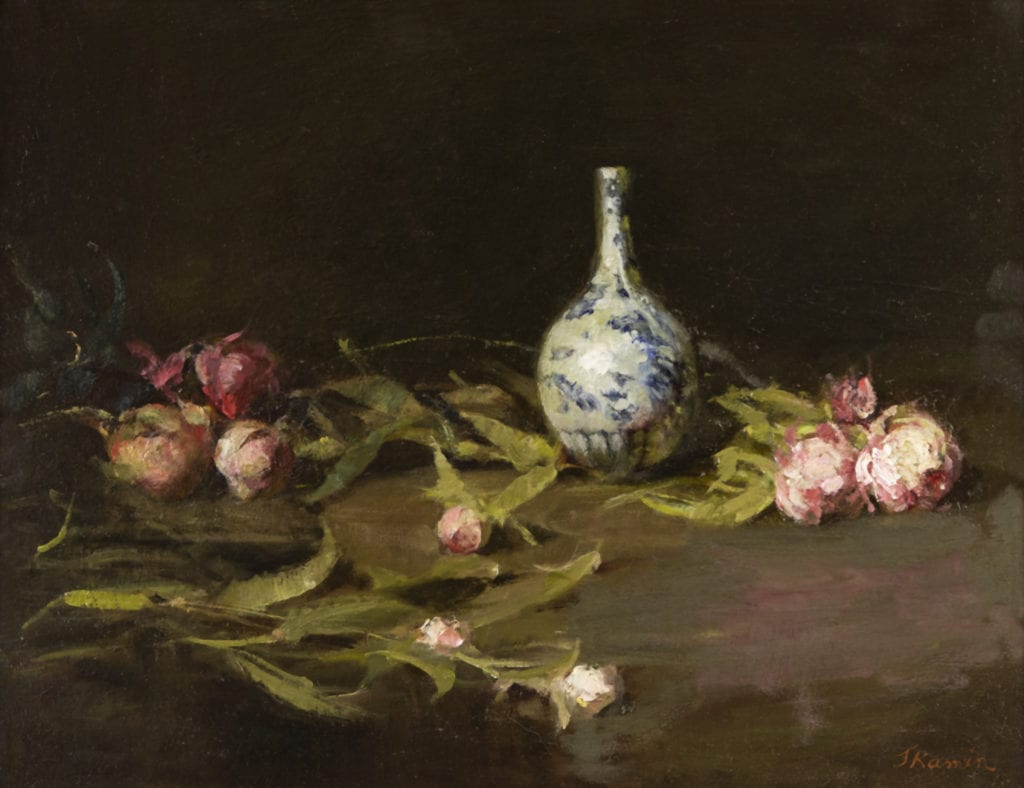
Moving to California in 1985 marked the beginning of my serious pursuit of becoming an artist. A real turning point came when I met David Leffel OPAM. I had initially met him in New York City years earlier at the Art Students League, but when we met again in California at a workshop in Ojai, I connected with him right away. I have since painted and taken many workshops with him over the last twenty-five years. He has not only shaped the way I paint and understand painting, but he has also influenced the way in which I relate to my students. Teaching the concept of Abstract Realism (where paint represents something recognizable and yet is beautiful as paint itself) is a concept that David and Sherrie McGraw OPAM coined. Reaching students on their level and teaching them to be more sensitive has been a wonderful endeavor and it has helped expand my own skills as a painter and a teacher as well.

The most important requirement in learning to be an artist is the desire to paint. The best way to get started is have a collection of resources and references, like photos, sketches and other artists’ work that you admire. This can be inspirational when looking for ideas to paint. Keep a sketchbook for ideas about future paintings where you can capture something that inspires you and use it as reference once you are back in your studio. A sketchbook is a very important tool that trains your artistic skills and serves as a reference for painting ideas.

Paint a subject that inspires you. I love painting landscape, flowers and still life objects. I am most inspired when I‘m traveling in nature and when exploring antique shops. It’s really not about the subject matter as such, but rather it’s about the light falling on objects and the shapes of light and shadow and the abstract idea that the subject matter suggests. Painting is an opportunity for you to be yourself using paint and color to express feelings and passion. Find your fun and gratification in the journey, not the destination.
I think a lot of people are frightened by doing something differently. Your local teacher may be teaching you in a particular way that makes you feel awkward. Perhaps it is the subject matter. I suggest that you try some other subject matter or other technique until you find what resonates with you. When I teach, I share how painting works. Rather than teaching a technique or formulas, I teach how painting works. Once you understand this, you will be able to paint your ideas and paint what inspires you. When you learn about color, edges, composition, paint quality, and making form, you are equipped to paint your ideas as this knowledge is what goes into making a good painting. Whether you want to paint dogs, horses, landscape, people, interiors or flowers – whatever it is that you envision in your mind that you would love to paint, learning the principles behind painting will give you the ability to do just that.

Don’t worry about learning technique. Early on David said a powerful thing to me: “Paint the visual idea and technique will catch up to express it.” This made immediate sense and was life-changing in its simplicity. To this day, his philosophy guides me when teaching others. Paint the idea—the beauty that you see in your subject—then you’ll find a way to express it.
“Don’t learn to paint; paint to learn.” David A Leffel OPAM
I must quote him here for he is the mentor that allowed me to follow my dream of becoming an artist. His approach to painting was always so simple, clear and beautiful. These are the concepts that I pass on to my students.
Keep it simple. Learning to paint is learning to see simply, which is a harder lesson than it seems, and one that somehow eludes students the most. What you put in your painting is as important as what you leave out.
Make brushstrokes. Their speed and direction will describe the textural quality of what you are painting and is the lifeblood of the painting. Economy of brushstrokes is another aspect of painting I try to teach my students.

There are just a few things you need to learn. Learning to become an artist takes patience, perseverance and practice, but if you love it enough, you’ll be able to achieve it. Remember, the only tools available to the artist are color, value, edges and paint quality. These are the fundamental elements used to create a painting.
See abstractly. It’s necessary to see beyond assumptions to develop visual clarity. Try to keep the subject as abstract as possible for as long as possible, and perhaps for you too, painting may become—as it has for me—an essential part of your being…as natural as breathing.
Leave a Reply